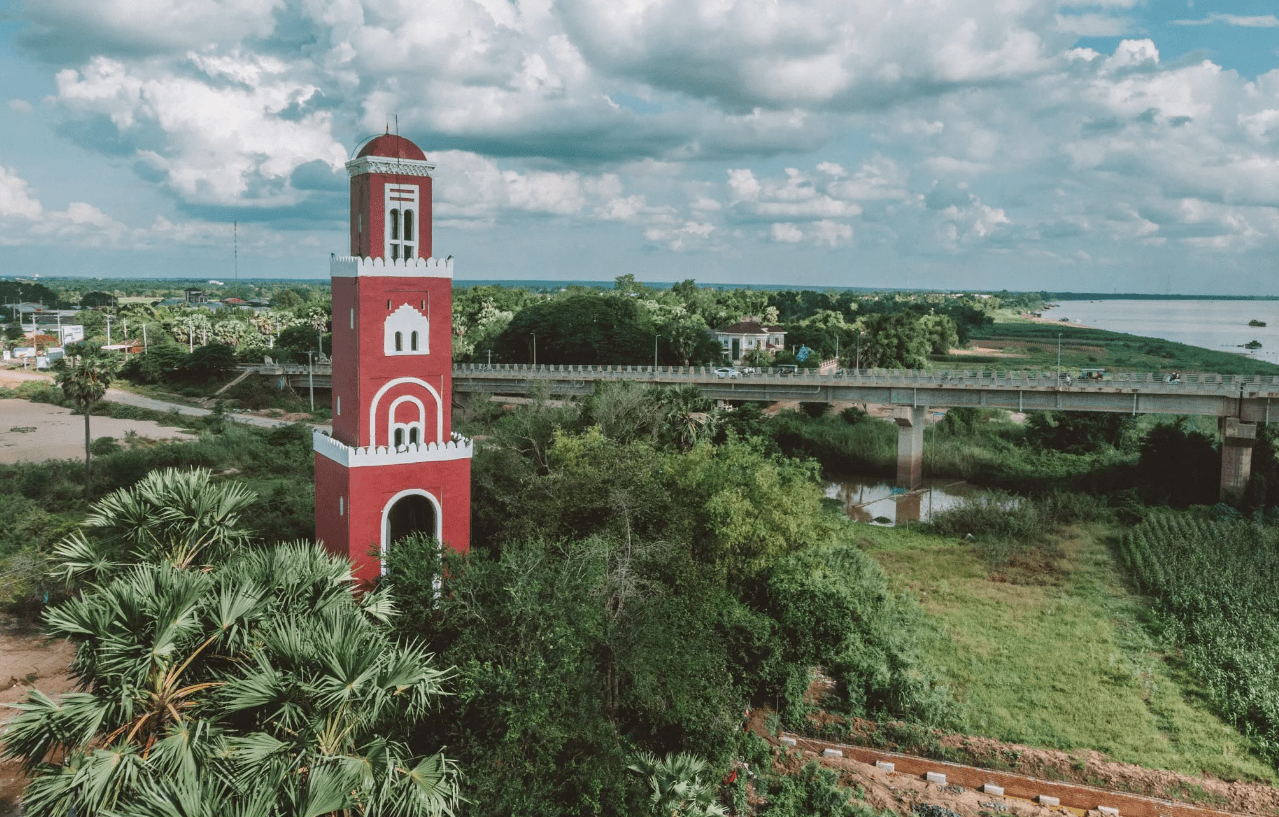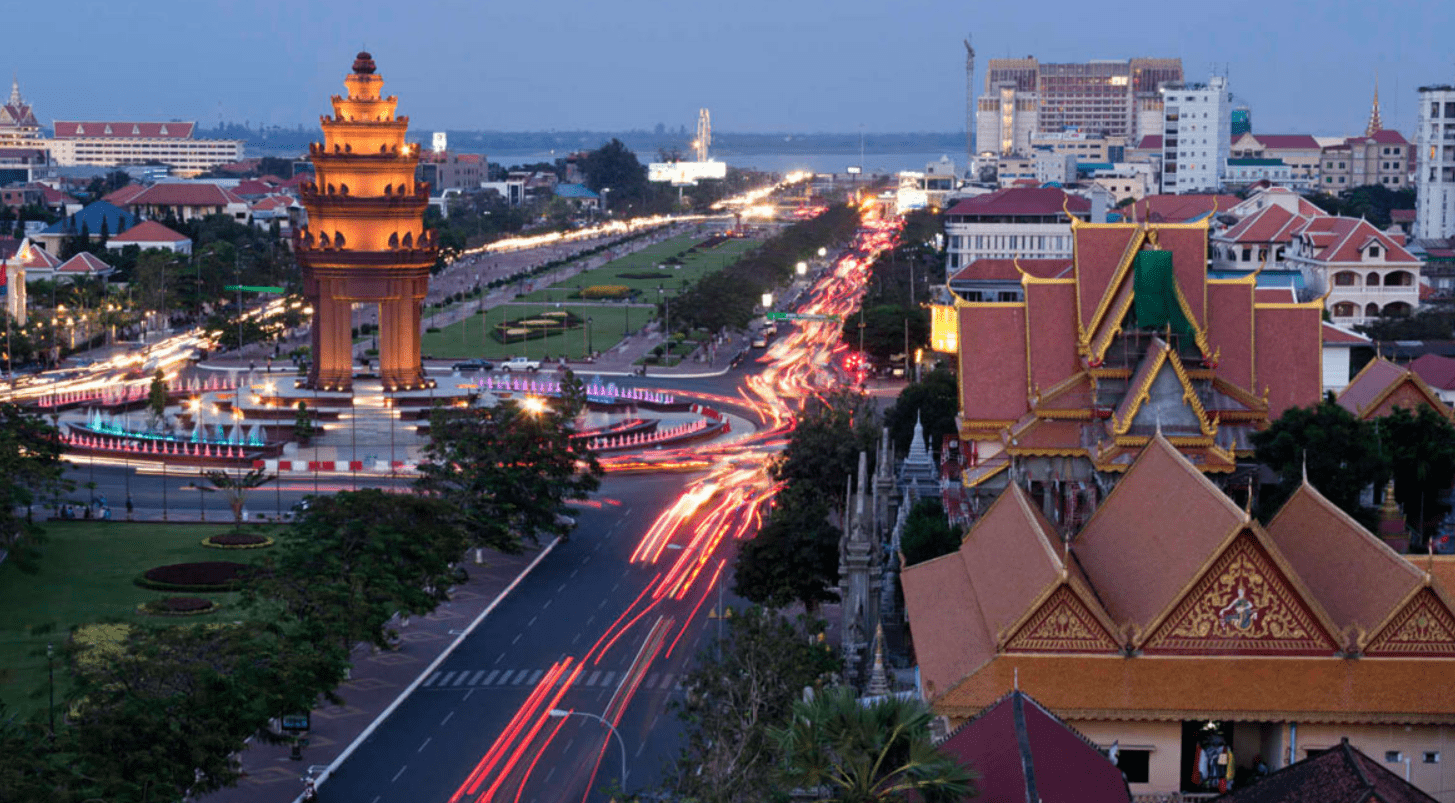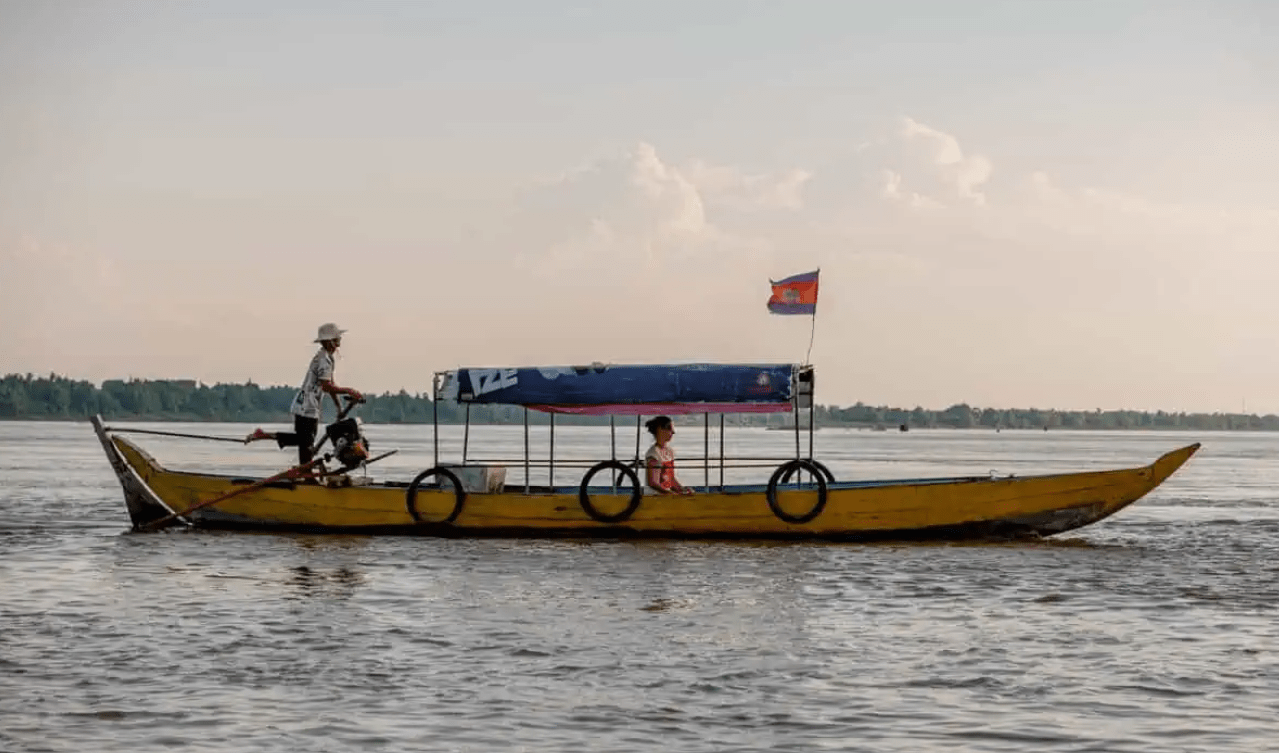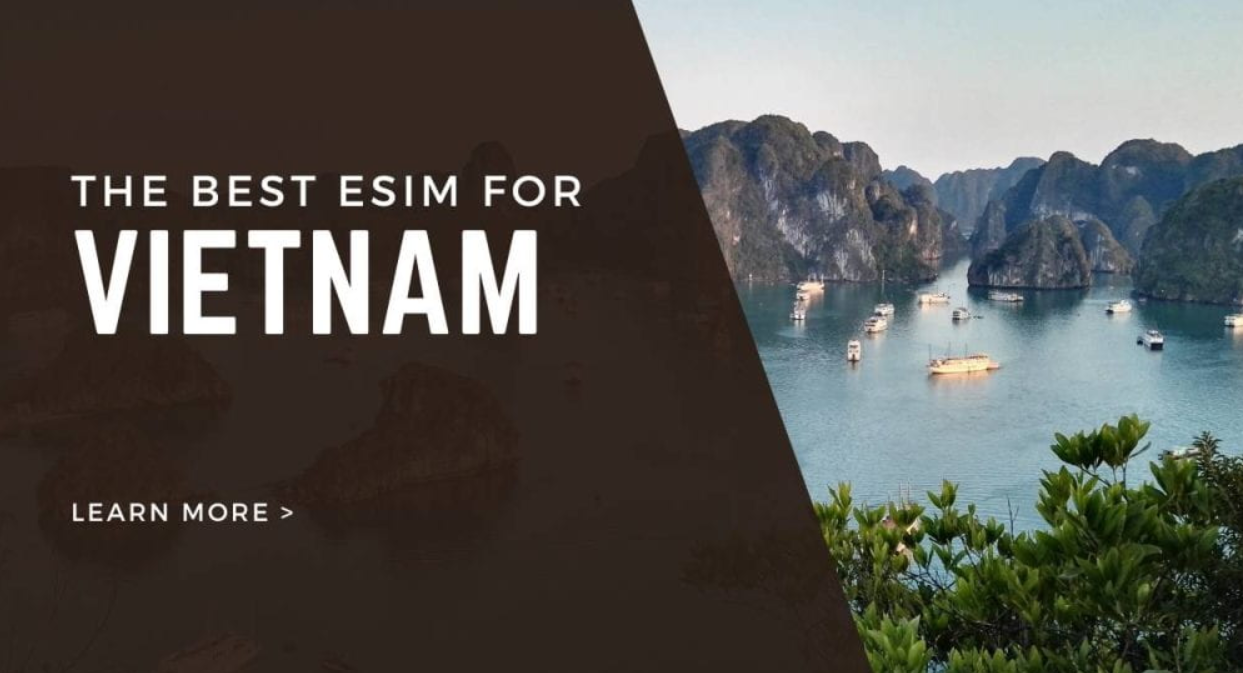Kampong Cham is unequivocally my favorite provincial city in Cambodia. This comprehensive guide will reveal the top attractions in Kampong Cham, including dining and drinking spots, accommodation options, and the best way to travel there by bus from Phnom Penh.
During my time in Phnom Penh, I longed for small-town charm. I yearned for a place where I could stroll without the stress of traffic, spend leisurely mornings at a market, cycle through lush landscapes, capture intriguing architecture, and enjoy street food.
When I had the chance to visit Kampong Cham for a work trip, I discovered my ideal destination. Since my initial trip in 2015, I’ve returned to Kampong Cham at least four times, most recently on a solo journey.
This delightful town has captivated me completely!
Kampong Cham’s main street. Lush and picturesque!
Named after the Cham ethnic group of the region and hosting a significant portion of Cambodia’s Muslim community, Kampong Cham city offers a distinct atmosphere compared to the rest of the country. Strolling down the main boulevard, with its vividly painted colonial structures and Chinese shopfronts, and glimpsing the Mekong River from every side street, feels like stepping into a different world.
While Phnom Penh and Siem Reap are essential stops, Kampong Cham (along with Kampot, Kratie, and Battambang) offers a unique experience. Though it may sound clichéd, it’s here that you can truly encounter the authentic Cambodia.
The relaxed pace of life in Kampong Cham is a welcome change. With fewer tuk-tuks, reduced traffic, and minimal pollution, it’s a serene place. Tourists are rare, which means the locals are especially welcoming. With excellent dining options, impressive temples, and some of the most beautiful villages in Southeast Asia, Kampong Cham is sure to capture your heart.
Having traveled extensively across Cambodia, Kampong Cham remains my favorite provincial town. This guide compiles all my insights and enthusiasm for the town. I hope it helps you plan your own Kampong Cham adventure!
Where to Stay in Kampong Cham
Kampong Cham offers a selection of guesthouses and hotels, mostly situated along the waterfront, which is the preferred area for accommodation. Rooms usually don’t book up quickly, but it’s wise to reserve a couple of days in advance to avoid disappointment.
Budget: Mekong Hotel, a large 70-room riverfront property, is Kampong Cham’s most popular hotel. Though a bit worn, it is generally clean. AC rooms start at $10. I stayed here on my first visit. For a more unique experience, try Moon River Guesthouse (from $11), featuring simple rooms with en suites and a well-regarded restaurant downstairs. Daly Hotel (from $13) offers basic rooms with balconies overlooking the city.
Mid-range: I used to recommend Reasmey Cheanich, but the rooms have deteriorated significantly since my last stay (due to a serious mold issue). Instead, consider LBN Asian Hotel, Kampong Cham’s newly opened ‘luxury’ hotel. Rooms are designed with local preferences in mind (heavy furniture, limited natural light) but include an indoor pool. Doubles start from $29.
Homestay: OBT Homestay Chiro, run by the NGO Organization for Basic Training, offers rustic bamboo bungalows. Located 7km outside town in a small village, it provides an authentic Cambodian experience and a peaceful escape.
Resort: Hanchey Bamboo Resort, an eco-retreat managed by the local NGO Buddhism for Social Development Action (BSDA), features luxurious rooms and hosts yoga retreats in a stunning bamboo pavilion. It’s about a 40-minute drive from the city center, making it more suitable for an overnight stay rather than a base.
Out-of-the-box: Mekong Bamboo Hut on Koh Pen, an island adjacent to Kampong Cham’s waterfront, offers rustic riverside hammocks. It was closed and up for sale during my last visit, but it might reopen in time for high season.
Essential Travel Information
Kampong Cham city (also known as Krong Kampong Cham) is the largest settlement in Kampong Cham Province. It’s located approximately three hours north of Phnom Penh along one of Cambodia’s better roads. Kampong Cham serves as a gateway to the north and far east of Cambodia, making it ideal for a one or two-night stopover between the capital and Kratie (or Don Det and the Laos border), Ratanakiri, or Mondulkiri.
Detailed transportation instructions, including recommended bus companies and online ticket purchasing options, are available at the end of this post.
When to Visit Kampong Cham
Kampong Cham, like much of Cambodia, is prone to flooding during the wet season. The weather has become increasingly unpredictable, but it’s generally advisable to avoid the peak rainy months of August and September. In past years, heavy rain has caused significant damage to the city’s main road and riverside promenade.
December, January, and February are the driest months. March and April are extremely hot, with temperatures reaching 40° Celsius, so it’s best to avoid these months unless you enjoy intense heat and dust.
During my last visit in September, typically the height of the monsoon season, I only encountered afternoon storms. Traveling during the rainy season has its perks—everything is lush and green, there are Buddhist festivals, cooler temperatures, and a more vibrant atmosphere.
In summary, my favorite times to visit Kampong Cham and Cambodia are from May to July and from the end of September to November.
How Long to Spend in Kampong Cham
Two full days is an ideal duration to explore Kampong Cham. Within 48 hours, you can leisurely explore the city and venture into the surrounding countryside by bike or motorbike.
On my last visit, I spent four days in Kampong Cham and never felt bored. I enjoyed the laid-back atmosphere, the ritual of visiting the market each morning, and watching the sunset over the river. Being one of the few tourists in town occasionally adds to the charm. It’s a wonderful place to take a break and relax for a few days.
ATMs & Money
Unlike Phnom Penh or Siem Reap, most cafes and restaurants in Kampong Cham only accept cash. It’s essential to have US dollars or, preferably, riel for local markets and tuk-tuks.
Kampong Cham has numerous ATMs from all major banks. The ABA Bank on Preah Monivong Street offers both USD and Cambodian riel and has the lowest withdrawal fee in Cambodia at $4 per transaction.
ATMs attached to reputable banks are open 24/7 and are monitored by security guards.
Getting Around
The central area of Kampong Cham is small enough to explore on foot. Most major attractions and restaurants are easily accessible along the riverside.
To reach the lighthouse and temples, I recommend renting a bicycle from Lazy Mekong Daze (2 USD for a full day). They also offer motorbikes. The owner is friendly and can provide useful local tips. Pay in advance and, if visiting during high season, consider reserving your bike a day ahead.
For hot or rainy days, you can use PassApp to book tuk-tuks or taxis.
Things to Do in Kampong Cham
Kampong Cham offers plenty of activities for a town of its size. Here are some of my favorite things to do:
At the end of this section, you’ll find a helpful Kampong Cham map with all the mentioned points of interest marked.
Browse the Market
In Cambodia, a visit to the local wet market is the best way to start the day. Kampong Cham’s main market is centrally located and features an array of undercover stalls selling clothing, textiles, and haberdashery. At the market’s entrance and exit, you can enjoy bowls of steaming bo bor.
The market’s French-inspired design resembles Phnom Penh’s Central Market and Battambang’s main phsar. The market has a timeless feel, with its clock and architectural details.
Seafood, particularly the giant, juicy snails from rice paddies and riverbanks, dominates the market. Fresh, dried, and BBQ’d fish, crab, and shrimp are abundant.
The market’s dimly lit atmosphere, with hanging bulbs casting dramatic light, makes it a fantastic place for photography. Locals, accustomed to few foreign tourists, are generally very welcoming.
Outside the market, fruit and vegetable vendors line the perimeter and spill into nearby streets. In the evening, fruit stalls give way to barbecue stands selling grilled fish and skewered meats.
Admire the Architecture
Kampong Cham’s city center features a charming blend of French, Chinese, and Khmer architectural styles. Spend hours biking along the wide boulevards and narrow streets, admiring well-preserved colonial buildings with original plaster moldings and wooden shutters.
Stroll Along the Riverside
Kampong Cham’s highlight is its expansive Riverside Park. This pedestrian promenade stretches from the Japanese Bridge to the end of the main street, following the Mekong River’s curve.
Shaded by tall palms and bougainvillea, the park features benches and occasional quirky statues, like the Kampong Cham dolphin.
At sunset, the park becomes a lively hub of aerobics, street food vendors, and families out for evening strolls.
Visit the French ‘Lighthouse’
On a clear day, you can spot a tall auburn building across the river. Known as the French ‘lighthouse,’ it’s actually a watchtower built in the 1920s. It was used to protect the local rubber plantations from bandits. A fire would be lit in the tower to alert the Governor of any threats.
To visit, cycle, motorbike, or walk over the Japanese Bridge and take a left when you reach the opposite bank. The tower is open 24/7



